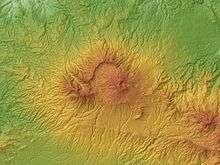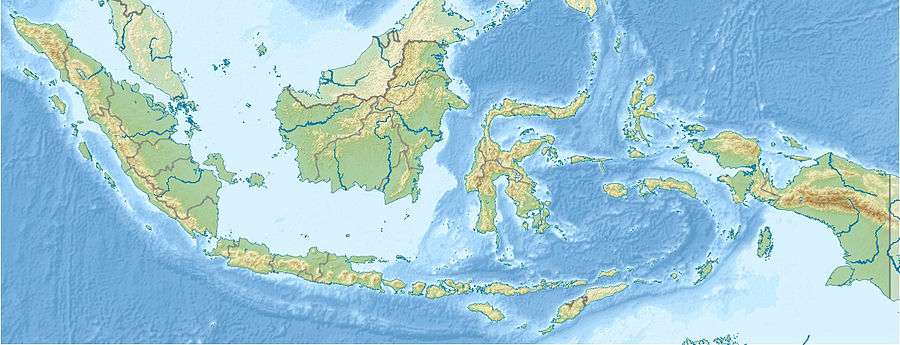Tangkuban Perahu
| Tangkuban Perahu | |
|---|---|
 | |
| Highest point | |
| Elevation | 2,084 m (6,837 ft) [1] |
| Listing | Spesial Ribu |
| Coordinates | 6°46′S 107°36′E / 6.77°S 107.60°ECoordinates: 6°46′S 107°36′E / 6.77°S 107.60°E [1] |
| Geography | |
| Geology | |
| Mountain type | Stratovolcano |
| Last eruption | 2015[1] |
| Climbing | |
| First ascent |
1713 Abraham van Riebeeck |
| Easiest route | Hike |

Tangkuban Perahu (spelt Tangkuban Parahu in the local Sundanese dialect) is a stratovolcano 30 km north of the city of Bandung, the provincial capital of West Java, Indonesia. It erupted in 1826, 1829, 1842, 1846, 1896, 1910, 1926, 1929, 1952, 1957, 1961, 1965, 1967, 1969, 1983, and 2013. It is a popular tourist attraction where tourists can hike or ride to the edge of the crater to view the hot water springs and boiling mud up close, and buy eggs cooked on the hot surface.[2] Together with Mount Burangrang and Bukit Tunggul, it is a remnant of the ancient Mount Sunda after the plinian eruption caused the Caldera to collapse.
In April 2005 the Directorate of Volcanology and Geological Hazard Mitigation raised an alert, forbidding visitors from going up the volcano. "Sensors on the slopes of the two mountains - Anak Krakatoa on the southern tip of Sumatra Island and Tangkuban Perahu in Java - picked up an increase in volcanic activity and a build up of gases, said government volcanologist Syamsul Rizal."[3] On the mountain's northern flank is Death Valley, which derives its name from frequent accumulation of poisonous gases.[4]
Eruptive History
A study conducted in 2001 determined that Tangkuban Perahu has erupted at least 30 times in the previous 40,750 years. Studies of the tephra layers within 3 km of the crater revealed that twenty one were minor eruptions and the remaining nine were major eruptions. The eruptions that occurred prior to approximately 10,000 years ago were magmatic/phreatomagmatic. The eruptions that occurred after 10,000 years ago were phreatic."[5] The volcano erupted as recently as October 5, 2013.[6]
Legend
The name translates roughly to "upturning of (a) boat" or "upturned boat" in Sundanese, referring to the local legend of its creation. The story tells of "Dayang Sumbi", a beauty who lived in West Java. She cast away her son "Sangkuriang" for disobedience, and in her sadness was granted the power of eternal youth by the gods. After many years in exile, Sangkuriang decided to return to his home, long after the two had forgotten and failed to recognize each other. Sangkuriang fell in love with Dayang Sumbi and planned to marry her, only for Dayang Sumbi to recognize his birthmark just as he was about to go hunting. In order to prevent the marriage from taking place, Dayang Sumbi asked Sangkuriang to build a dam on the river Citarum and to build a large boat to cross the river, both before the sunrise. Sangkuriang meditated and summoned mythical ogre-like creatures -buto ijo or green giant(s)- to do his bidding. Dayang Sumbi saw that the tasks were almost completed and called on her workers to spread red silk cloths east of the city, to give the impression of impending sunrise. Sangkuriang was fooled, and upon believing that he had failed, kicked the dam and the unfinished boat, resulting in severe flooding and the creation of Tangkuban Perahu from the hull of the boat.
See also
References
- 1 2 3 "Tangkubanparahu". Global Volcanism Program. Smithsonian Institution. Retrieved 2010-11-06.
- ↑ There are numerous tourist attractions in the mountains around Bandung, many of which are related to the interesting geology of the region. There are a number of volcanoes and volcanic craters close to Banding, such as the Kawah Putih crater lake around 50 km to the south.
- ↑ http://www.thejakartapost.com/detaillatestnews.asp?fileid=20050413185123&irec=1 thejakartapost.com
- ↑ Mount Tangkuban Perahu Tourism, indonesia-tourism.com
- ↑ Kartadinata, Okuno, Nakamura & Kobayashi, Eruptive History of Tangkuban Perahu Volcano, West Java, Indonesia : A Preliminary Report, Journal of Geography, 2001
- ↑ Smithsonian Institution Global Volcanism Program
External links
- Volcano World: Tangkuban Perahu
- Tangkuban Perahu by JoTravelGuide.com - A main tourist attraction near Bandung
| Wikimedia Commons has media related to Tangkuban Perahu. |

